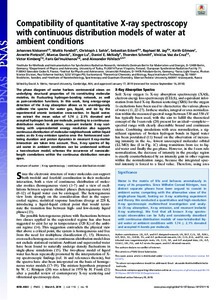Compatibility of quantitative X-ray spectroscopy with continuous distribution models of water at ambient conditions
Johannes Niskanen; Mattis Fondell; Christoph J. Sahle; Sebastian Eckert; Raphael M. Jay; Keith Gilmore; Annette Pietzsch; Marcus Dantz; Xingye Lu; Daniel E. McNally; Thorsten Schmitt; Vinicius Vaz da Cruz; Victor Kimberg; Faris Gel’mukhanov; Alexander Föhlisch
Compatibility of quantitative X-ray spectroscopy with continuous distribution models of water at ambient conditions
Johannes Niskanen
Mattis Fondell
Christoph J. Sahle
Sebastian Eckert
Raphael M. Jay
Keith Gilmore
Annette Pietzsch
Marcus Dantz
Xingye Lu
Daniel E. McNally
Thorsten Schmitt
Vinicius Vaz da Cruz
Victor Kimberg
Faris Gel’mukhanov
Alexander Föhlisch
NATL ACAD SCIENCES
Julkaisun pysyvä osoite on:
https://urn.fi/URN:NBN:fi-fe2021042823958
https://urn.fi/URN:NBN:fi-fe2021042823958
Tiivistelmä
The phase diagram of water harbors controversial views on underlying structural properties of its constituting molecular moieties, its fluctuating hydrogen-bonding network, as well as pair-correlation functions. In this work, long energy-range detection of the X-ray absorption allows us to unambiguously calibrate the spectra for water gas, liquid, and ice by the experimental atomic ionization cross-section. In liquid water, we extract the mean value of 1.74 +/- 2.1% donated and accepted hydrogen bonds per molecule, pointing to a continuous-distribution model. In addition, resonant inelastic X-ray scattering with unprecedented energy resolution also supports continuous distribution of molecular neighborhoods within liquid water, as do X-ray emission spectra once the femtosecond scattering duration and proton dynamics in resonant X-ray-matter interaction are taken into account. Thus, X-ray spectra of liquid water in ambient conditions can be understood without a two-structure model, whereas the occurrence of nanoscale-length correlations within the continuous distribution remains open.
Kokoelmat
- Rinnakkaistallenteet [27094]
